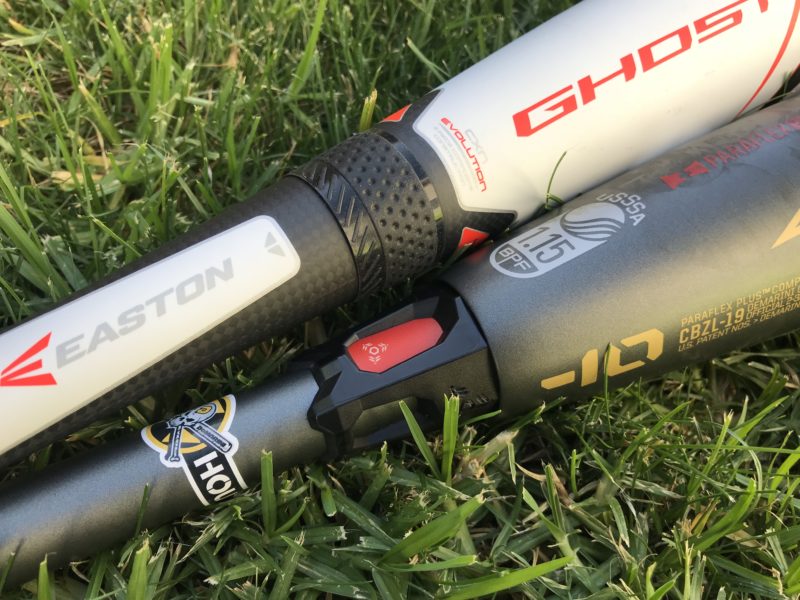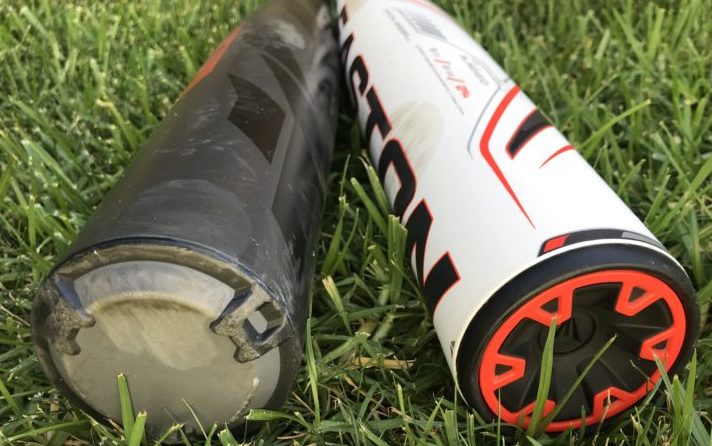
I finally had the chance to hit the 2019 Easton Ghost X Evolution Travel Ball Bat today. Coincidentally, my brand spanking new Pocket Radar Smart Coach arrived today as well. So, naturally, I had to do an exit speed comparison between the two new Ghost X and the best selling, super popular 2019 DeMarini CF Zen Travel Ball Bat for USSSA. This is less of a review and more of an all things being equal comparison of exit speeds. You should know, while exit speed is a good starting point, ball exit speeds actually mean very little about the overall quality and performance of a bat. There are so many variables that can change these numbers, and ultimately almost every high end bat we have ever tested fall within a few MPH of each other (when used by the same hitter).

Mini “Review”
A little info about both bats. Both bats used were 31″/21 ounce (minus 10) models. Longer, heavier bats will produce higher exit speeds (yet another reasons most people’s exit speed data is worthless). The 2019 CF Zen had probably 100 swings on it at testing, while the 2019 Easton Ghost X had approximately 30 swings at testing. Both bats felt very good on contact with little to no vibration (as should be expected in this price range). Both are great, high end, top of the line travel ball bats for USSSA, and ultimately there was very little difference, but there radar doesn’t lie: one bat did have a slightly higher average exit speed off both the machine and the tee.

Exit Speed Off the Pitching Machine
| Activity | Recorded Speed | Units |
| 2019 CF Zen USSSA 31/21 |
83 |
MPH |
| 2019 CF Zen USSSA 31/21 |
81 |
MPH |
| 2019 CF Zen USSSA 31/21 |
81 |
MPH |
| 2019 CF Zen USSSA 31/21 |
80 |
MPH |
| 2019 CF Zen USSSA 31/21 |
79 |
MPH |
| 2019 CF Zen USSSA 31/21 |
75 |
MPH |
| 2019 CF Zen USSSA 31/21 |
75 |
MPH |
| 2019 CF Zen USSSA 31/21 |
74 |
MPH |
| 2019 CF Zen USSSA 31/21 |
74 |
MPH |
| 2019 CF Zen USSSA 31/21 |
71 |
MPH |
| 2019 CF Zen USSSA 31/21 |
70 |
MPH |
| 2019 CF Zen USSSA 31/21 |
70 |
MPH |
|
76.08 |
Avg MPH | |
| 2019 Easton Ghost x 31/21 |
81 |
MPH |
| 2019 Easton Ghost x 31/21 |
81 |
MPH |
| 2019 Easton Ghost x 31/21 |
80 |
MPH |
| 2019 Easton Ghost x 31/21 |
80 |
MPH |
| 2019 Easton Ghost x 31/21 |
78 |
MPH |
| 2019 Easton Ghost x 31/21 |
77 |
MPH |
| 2019 Easton Ghost x 31/21 |
76 |
MPH |
| 2019 Easton Ghost x 31/21 |
75 |
MPH |
| 2019 Easton Ghost x 31/21 |
71 |
MPH |
| 2019 Easton Ghost x 31/21 |
71 |
MPH |
|
77 |
Avg MPH |
Exit Speed Off the Tee
| Activity | Recorded Speed | Units |
| 2019 CF Zen USSSA 31/21 |
74 |
MPH |
| 2019 CF Zen USSSA 31/21 |
75 |
MPH |
| 2019 CF Zen USSSA 31/21 |
77 |
MPH |
| 2019 CF Zen USSSA 31/21 |
81 |
MPH |
| 2019 CF Zen USSSA 31/21 |
74 |
MPH |
| 2019 CF Zen USSSA 31/21 |
76 |
MPH |
| 2019 CF Zen USSSA 31/21 |
75 |
MPH |
| 2019 CF Zen USSSA 31/21 |
77 |
MPH |
| 2019 CF Zen USSSA 31/21 |
82 |
MPH |
| 2019 CF Zen USSSA 31/21 |
77 |
MPH |
|
76.8 |
Avg. MPH | |
| 2019 Easton Ghost x 31/21 |
78 |
MPH |
| 2019 Easton Ghost x 31/21 |
80 |
MPH |
| 2019 Easton Ghost x 31/21 |
73 |
MPH |
| 2019 Easton Ghost x 31/21 |
78 |
MPH |
| 2019 Easton Ghost x 31/21 |
72 |
MPH |
| 2019 Easton Ghost x 31/21 |
82 |
MPH |
| 2019 Easton Ghost x 31/21 |
78 |
MPH |
| 2019 Easton Ghost x 31/21 |
76 |
MPH |
| 2019 Easton Ghost x 31/21 |
80 |
MPH |
| 2019 Easton Ghost x 31/21 |
76 |
MPH |
|
77.3 |
Avg. MPH |
Conclusion & Rant About Exit Speeds
Ball exit speeds outside of a controlled environment are totally worthless. Your kid could pick up a 33 inch high school bat and hit the ball with a higher exit speed off of soft toss, or a tee than their normal bat they use in games. Do not be deceived by ball exit speed ratings. They are completely, 100% worthless outside of a controlled environment. You need the exact same speed pitch, baseballs with the same number of hits on them, and exact same weather conditions to even begin to think about determining real, usable exit speed data. What matters is your player’s ability to hit well with a certain bat, and that bat will be different for different players and swings. This is hardly enough data to make any determination on which bat is better, but I do think it shows both bats will ultimately be similar in performance. Both bats are excellent, but the 2019 Easton Ghost, on average, hit the ball almost 1 MPH faster off the machine, and 0.5 MPH faster off a tee. Not a big deal at all in the big scheme of things. 1 MPH in exit speed translates to roughly 4 or 5 feet of distance on the field… Probably not a game changer, but notable nonetheless. Also note, the DeMarini Zen DID register the highest exit speed of all with an 83 MPH; the Ghost X top speed was 82 MPH today… not bad at all for being such light bats and not fully broken in.
About Me and the Data
I hit baseballs and softballs almost every day. Yes, I am an adult testing bats made for kids, girls, college players, and men, but I do this a lot and I’m kind of good at it. I correctly called ALL of the best USA bats this Spring before they were best sellers. I used the brand new Pocket Radar Smart Coach to record the exit speeds and export the data to a spreadsheet with their App. I threw out any data below 70 MPH (off the machine) because a ground ball or foul ball pop ups are on me, not the bat. Machine was throwing 50 MPH batting cage baseballs. Off the tee I was hitting new Diamond DOL-1 baseballs. It was almost 90 degrees out.

I have an all star son playing 8U ball on a sling. He is hitting very well with a Marucci wood bat. His composite Easton ghost X drop 11 is 2018 is like its to light for him now . 18 oz . he is ahead of the ball . We practice a lot reps with his wooden bat. He is hitting that better than the metal bats. I was thinking of getting him the 2019 Easton Ghost X evolution or the 2019 DeMarini Voodoo in the drop 5 . Both in Drop 5, which would be equal in weight to the Wood bat . 30 drop 5 – What is your opinion on that change ? In your experience. thanks
If the player is strong enough to swing a minus 5 I say go for it, but I have never personally seen an 8-year old using a minus 5 in travel ball… at least in actual games.